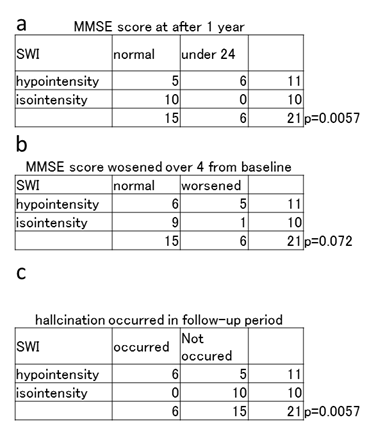Session Information
Date: Saturday, October 6, 2018
Session Title: Surgical Therapy: Parkinson's Disease
Session Time: 1:45pm-3:15pm
Location: Hall 3FG
Objective: This study was undertaken to predict cognitive worsening by pulvinar imaging in susceptibility-weighted imaging (SWI).
Background: Deep brain stimulation (DBS) for Parkinson’s disease (PD) is fixed useful therapy. However, deterioration of cognitive function after DBS is a big problem.
Methods: This study was conducted retrospectively. Inclusion criteria were as follows: a clinical diagnosis of PD [11], underwent DBS therapy since November 2010 to April 2016 and susceptibility-weighted imaging (SWI) was obtained by 3T MRI unit. Twenty-one patients matched these criteria. We examined the relationship between pulvinar hypointensity before DBS and cognitive change one year after DBS.
Results: Pulvinar hypointensity in SWI was found in 11 patients and not in 10 patients out of 21 PD patients at baseline. At one year from operation, 6 of 21 patients worsened 4 points or more in Mini-Mental State Examination score from baseline. And we could observe pulvinar hypointensity in 5 of the 6 patients (p=0.072). During the observation period, 6 of 21 patients showed hallucination (including both transient and permanent). We could observe pulvinar hypointensity in all these 6 patients. In 10 cases without pulvinar hypointensity, no patients showed hallucination. (Fig. 1 and 2)
Conclusions: Pulvinar hypointensity in SWI in PD patients may give us useful information to predict the prognosis after DBS.
References: Heo J, Lee K-M, Paek SH, Kim M-J, Lee J, Kim J-Y, et al. The effects of bilateral Subthalamic Nucleus Deep Brain Stimulation (STN DBS) on cognition in Parkinson disease. J Neurol Sci. 2008 Oct;273(1–2):19–24. Sugiura, M., Satoh, M., Tabei, K., Saito, T., Mori, M., Abe, M., … Tomimoto, H. (2016). Detection of Low-Signal Pulvinar Areas Using Diffusion-Weighted Imaging in Patients with Dementia Experiencing Visual Hallucinations. Dementia and Geriatric Cognitive Disorders Extra, 458–464.
To cite this abstract in AMA style:
K. Matsuura, M. Maeda, M. Satoh, K. Tabei, T. Araki, M. Umino, H. Kajikawa, N. Nakamura, H. Tomimoto. Pulvinar low intensity on susceptibility-weighted imaging may predict cognitive worsening after deep brain stimulation therapy in Parkinson’s disease patients [abstract]. Mov Disord. 2018; 33 (suppl 2). https://www.mdsabstracts.org/abstract/pulvinar-low-intensity-on-susceptibility-weighted-imaging-may-predict-cognitive-worsening-after-deep-brain-stimulation-therapy-in-parkinsons-disease-patients/. Accessed December 8, 2025.« Back to 2018 International Congress
MDS Abstracts - https://www.mdsabstracts.org/abstract/pulvinar-low-intensity-on-susceptibility-weighted-imaging-may-predict-cognitive-worsening-after-deep-brain-stimulation-therapy-in-parkinsons-disease-patients/


